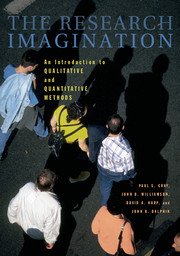Book contents
- Frontmatter
- Contents
- Preface
- 1 RESEARCH PROCESS
- 2 THEORY AND METHOD
- 3 RESEARCH DESIGN
- 4 MEASUREMENT
- 5 ETHICAL AND POLITICAL ISSUES
- 6 SAMPLING
- 7 SURVEY RESEARCH
- 8 INTENSIVE INTERVIEWING
- 9 OBSERVATIONAL FIELD RESEARCH
- 10 FEMINIST METHODS
- 11 HISTORICAL ANALYSIS
- 12 EXPERIMENTAL RESEARCH
- 13 CONTENT ANALYSIS
- 14 AGGREGATE DATA ANALYSIS
- 15 COMPARATIVE RESEARCH METHODS
- 16 EVALUATION RESEARCH
- 17 INDEXES AND SCALES
- 18 BASIC STATISTICAL ANALYSIS
- 19 MULTIVARIATE ANALYSIS AND STATISTICAL SIGNIFICANCE
- EPILOGUE: THE VALUE AND LIMITS OF SOCIAL SCIENCE KNOWLEDGE
- Appendix A A Precoded Questionnaire
- Appendix B Excerpt from a Codebook
- Author Index
- Subject Index
- References
13 - CONTENT ANALYSIS
Published online by Cambridge University Press: 05 June 2012
- Frontmatter
- Contents
- Preface
- 1 RESEARCH PROCESS
- 2 THEORY AND METHOD
- 3 RESEARCH DESIGN
- 4 MEASUREMENT
- 5 ETHICAL AND POLITICAL ISSUES
- 6 SAMPLING
- 7 SURVEY RESEARCH
- 8 INTENSIVE INTERVIEWING
- 9 OBSERVATIONAL FIELD RESEARCH
- 10 FEMINIST METHODS
- 11 HISTORICAL ANALYSIS
- 12 EXPERIMENTAL RESEARCH
- 13 CONTENT ANALYSIS
- 14 AGGREGATE DATA ANALYSIS
- 15 COMPARATIVE RESEARCH METHODS
- 16 EVALUATION RESEARCH
- 17 INDEXES AND SCALES
- 18 BASIC STATISTICAL ANALYSIS
- 19 MULTIVARIATE ANALYSIS AND STATISTICAL SIGNIFICANCE
- EPILOGUE: THE VALUE AND LIMITS OF SOCIAL SCIENCE KNOWLEDGE
- Appendix A A Precoded Questionnaire
- Appendix B Excerpt from a Codebook
- Author Index
- Subject Index
- References
Summary
INTRODUCTION
Content analysis is a systematic attempt to examine some form of verbal or image communication such as newspapers, diaries, letters, speeches, movies, or television shows. Usually this communication already exists, and the researcher wants to discover its implications for the study of human behavior. Content analysis can be either inductive or deductive theoretically, but it is primarily quantitative because the examination of communication usually occurs through counting its content. Like other quantitative techniques, the most creative part of the method is concentrated toward the early stages of research design, when the categories to be used for counting have to be defined. In developing their ingenious data collection tools, practitioners of content analysis demonstrate their research imagination.
The analysis of communication content has a long tradition in the social sciences. It has revealed significant information about the values of both communicators and their audiences. This chapter summarizes the major elements of this methodology, offers some examples of its application, and discusses some of the reliability and validity issues that arise for the investigators who use it.
Consider the following example from the work of Simon Davis (1990), who analyzed personal advertisements to see what motivates mate selection. Do men and women differ in the factors seen as important in choosing a partner? Davis pursued this question by looking at the “personals” section in a major daily newspaper.
Information
- Type
- Chapter
- Information
- The Research ImaginationAn Introduction to Qualitative and Quantitative Methods, pp. 283 - 304Publisher: Cambridge University PressPrint publication year: 2007
References
Accessibility standard: Unknown
Why this information is here
This section outlines the accessibility features of this content - including support for screen readers, full keyboard navigation and high-contrast display options. This may not be relevant for you.Accessibility Information
- 1
- Cited by
